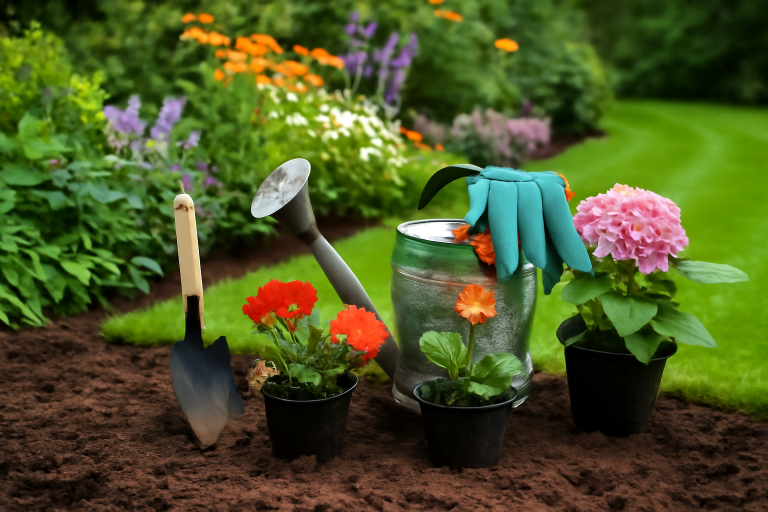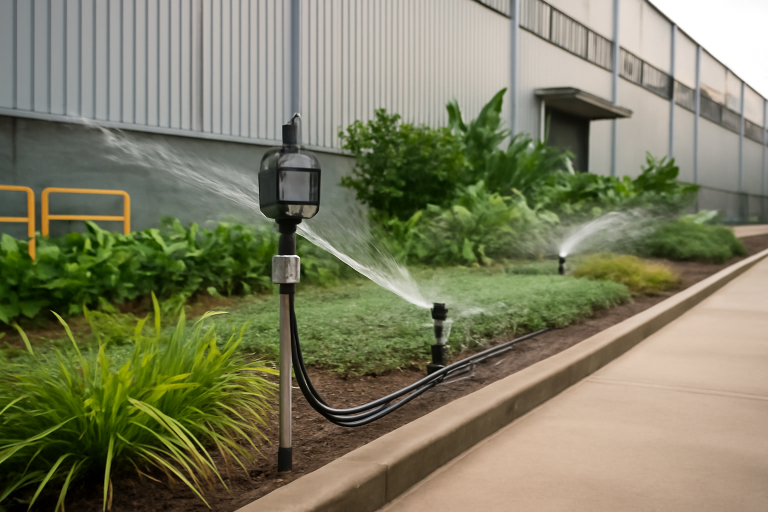In large industrial spaces, maintaining greenery can be challenging due to the size of the area, the variety of plants, and the demands of a busy workplace. One of the key solutions to ensuring plants thrive in such environments is the implementation of automated irrigation systems. These systems not only save time and labor but also ensure that plants receive the appropriate amount of water they need, improving their health and sustainability. In this article, we will discuss the importance of automated irrigation systems for industrial gardens, their benefits, and how they can be integrated into a modern industrial workspace.
1. What is Automated Irrigation?
Automated irrigation refers to the use of technology to water plants without manual intervention. The system is designed to deliver a precise amount of water to the plants based on their specific needs, soil moisture levels, and environmental conditions. Automated systems can be set to run on a schedule, or they can be equipped with sensors that detect when watering is necessary.
There are several types of automated irrigation systems available, including:
- Drip Irrigation: This system delivers water directly to the base of each plant through a network of tubes and emitters, ensuring efficient water use.
- Sprinkler Systems: These systems spray water over a large area, similar to rain, making them ideal for larger gardens or lawns.
- Soaker Hoses: These porous hoses allow water to seep out slowly, providing consistent moisture to the soil.
- Smart Irrigation: Using sensors and weather data, smart irrigation systems can adjust watering schedules based on real-time conditions, optimizing water use.
Automated systems are an excellent solution for industrial gardens, where the space is often large, and maintaining a consistent watering schedule can be time-consuming and inefficient.
2. The Benefits of Automated Irrigation for Industrial Gardens
Implementing an automated irrigation system in an industrial garden offers numerous benefits that help improve efficiency, sustainability, and plant health.
- Water Efficiency: Automated irrigation systems are designed to deliver water directly to the plant’s root zone, reducing evaporation and runoff. This leads to more efficient water use, ensuring that the plants receive the right amount of water without wasting resources. This is particularly important in areas where water conservation is a priority.
- Time Savings: Manually watering large industrial gardens can be time-consuming and labor-intensive. Automated systems eliminate the need for employees to spend hours watering plants, freeing up time for other tasks. This is especially valuable in industrial environments, where efficiency is key.
- Consistent Watering: Plants in industrial gardens require consistent watering to thrive. Automated systems can be programmed to deliver water at the same time every day or based on soil moisture levels, ensuring that plants receive the appropriate amount of water, even when there is no one available to tend to them. This consistency leads to healthier plants and reduces the risk of overwatering or underwatering.
- Reduced Labor Costs: By automating the watering process, businesses can reduce labor costs associated with plant maintenance. Instead of having to assign personnel to manually water plants, the system runs independently, reducing the need for constant human oversight.
- Sustainability: Automated irrigation systems help reduce water waste by targeting specific areas that need watering. This contributes to a more sustainable environment by minimizing water consumption and reducing the environmental impact of irrigation practices.
- Customization and Flexibility: Automated systems can be tailored to meet the specific needs of different plants. For example, some plants may require more frequent watering, while others may need less. An automated system allows for precise control over water distribution, ensuring each plant gets exactly what it needs.
3. How to Implement an Automated Irrigation System in Industrial Gardens
Implementing an automated irrigation system in an industrial garden is a relatively straightforward process, but it requires careful planning and consideration of various factors. Here’s how to get started:
- Assess the Garden Layout: The first step is to assess the size and layout of the garden. Determine where the plants are located and whether they require different types of irrigation. For example, larger plants or lawns may benefit from a sprinkler system, while smaller plants or garden beds may be better suited for drip irrigation.
- Choose the Right System: Based on the garden layout, select the most appropriate irrigation system. Drip irrigation is ideal for smaller, more delicate plants, while sprinklers are better suited for larger areas. Smart irrigation systems are a great choice for gardens with varying plant needs or where water conservation is a priority.
- Install the System: Once you’ve chosen the irrigation system, it’s time to install it. For drip irrigation, lay out the tubing along the rows of plants, ensuring that the emitters are positioned at the base of each plant. For sprinkler systems, place the sprinklers in areas that will provide even coverage for the garden. Smart irrigation systems may require additional sensors and software to monitor moisture levels and adjust the watering schedule accordingly.
- Set Up the Controller: Most automated irrigation systems come with a controller that allows you to set watering schedules and customize the system. Depending on the system, you can program the controller to water the garden at specific times of day, adjust for seasonal changes, and monitor water usage. For smart irrigation systems, the controller may automatically adjust based on weather conditions or soil moisture readings.
- Test and Monitor: After installation, test the system to ensure it’s working properly. Check that the water is being distributed evenly and that the plants are receiving the appropriate amount of water. Monitor the system regularly to ensure it’s functioning as expected and make adjustments if needed.
4. Maintenance and Troubleshooting
While automated irrigation systems require less maintenance than manual watering, it’s important to check the system regularly to ensure it’s working effectively.
- Clean the Filters: Many irrigation systems have filters that need to be cleaned periodically to prevent clogging. Dirty filters can reduce water flow and affect the efficiency of the system.
- Check for Leaks: Inspect the hoses, emitters, and sprinklers for leaks or damage. Even a small leak can lead to water waste and reduce the effectiveness of the system.
- Adjust for Seasonal Changes: As weather conditions change, it’s important to adjust the watering schedule. In the summer, plants may require more water, while in the winter, watering needs may decrease. Many smart irrigation systems automatically adjust to seasonal changes, but it’s still a good idea to monitor and make manual adjustments if necessary.
- Test Sensors and Controllers: For systems with sensors and controllers, make sure the sensors are properly calibrated to detect moisture levels accurately. Regularly check the controller to ensure it’s operating correctly and that the watering schedule is still appropriate for the current plant needs.
5. Conclusion
Automated irrigation systems are a game-changer for industrial gardens. They offer a more efficient, sustainable, and cost-effective way to maintain greenery in large industrial spaces. By reducing water waste, saving time, and ensuring consistent watering, these systems help create healthier plants and reduce the overall environmental impact. Whether you’re managing a rooftop garden, a green wall, or a large industrial landscape, an automated irrigation system can make the task of plant care much easier and more effective.
Investing in an automated irrigation system not only benefits the plants but also helps businesses improve sustainability, reduce labor costs, and create a more comfortable and productive environment for workers.

